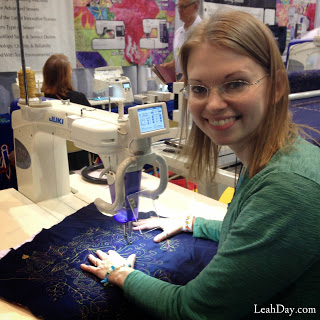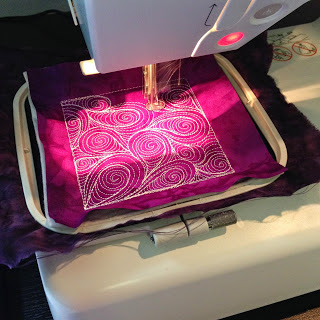Quilting on a Home Machine Versus Longarm Machine
 |
| Josh is machine quilting on a regular home sewing machine. |
One of the most confusing things to beginners is our terminology so here’s a list of all the ways you can describe a home sewing machine:
Home sewing machine
Domestic machine
Midarm machine
Sit Down Machine / Sit Down Longarm
Table Mounted Machine / Table Mounted Longarm
This can obviously be confusing when you start talking about longarm machines, which are typically just called longarms or rail mounted longarm.
It’s even more confusing when a quilter takes a home sewing machine and mounts it onto a rail system. Technically even though the machine is small, when it’s mounted onto a rail system it becomes a longarm.
So what is the difference? As I demonstrated in the video with my silly stapler and Post-it note puppets, the difference is what moves – the quilt or the machine.
 |
| Here I’m quilting on a table mounted longarm, moving the quilt, not the machine. |
When the machine is stationary, you move the quilt under the needle for machine quilting. When the machine is on a rail system, you move the machine over the quilt.
Regardless of which is moving – the quilt or the machine – the goal of machine quilting designs are the same:
We want to fill our quilts with designs that flow continuously with minimal thread breaks. A quick name for this type of design is Continuous Line Design, which simply means the design flows without stopping in a continuous line.
So how can we tell the quilting on a longarm apart from the quilting on a home sewing machine? Theoretically we can’t! If I quilted Stippling on my home machine and another quilter quilted this design on her longarm and if the two quilts were placed side by side, you wouldn’t be able to tell how it was quilted.
However, the path that we use to fill a quilt can be quite different. For quilting on a home machine, we must baste the entire quilt, then machine quilt it starting in the middle of the quilt and working our way steadily to the outside edges. This way any extra fabric or batting will be free to shift outwards as needed.
For a longarm, the quilt is mounted onto a rail system that’s a bit more like a typewriter. The quilt is fed up onto rails so you begin quilting at the top of the quilt and fill it in rows as the quilt is advanced onto the rails.. The size of your rails and your longarm determine how much space you can quilt at any given time.
So why do some quilts look so obviously longarm quilted?
Yes, there is one tell for longarmed quilts that’s very obvious – pantographs and digitized designs.
Longarms are designed to quilt a path horizontally across the quilt and many quilters take advantage of this by using simple pantograph patterns to quilt a repeating design from left to right or right to left across the quilt. The pantograph is printed on a roll of paper and spread out behind the longarm. Using a stylus, you can move the machine from the back, following the design marked on paper.
 |
| This design is being stitched automatically by my embroidery machine. |
Computerization has made this even easier with systems that will automatically move the machine through a pantograph pattern. Much like an embroidery machine stitches out a design automatically, a longarm can be set up to quilt across the quilt with a repeating design with no assistance other than the occasional check for tension and thread breaks.
Both types of designs appear obviously longarmed because they are repeated identically across the quilt. Your eye can easily catch that same heart or leaf shape repeated in the same pattern over and over.
Why doesn’t this happen with home sewing machine quilting?
It’s far less common to see a pantograph quilted on a home sewing machine because it’s really hard to quilt like this when you’re moving the quilt, not the machine. The only way I can think of quilting a repeating design across the quilt is to mark it entirely over the whole surface of the quilt, which is both time consuming and tedious.
It’s also not a very natural way to quilt on a home machine because it’s harder to move the entire quilt from edge to edge through the machine. It’s far easier to machine quilt from the center instead.
Which type of quilting is better?
Neither! No matter whether you machine quilt on a home machine or a longarm, you’re quilting and that’s what really matters!
The awesome thing is you can use the exact same designs on both longarm machines and home machines so the best thing you can do is dig into designs and start quilting – no matter what machine you own.
Click Here to browse our gallery of over 450 continuous line free motion quilting designs.
Let’s go quilt,
Leah Day

Had I known how difficult it would be to quilt a queen-sized quilt on a home machine, I never would have done it. But once I started it, I am committed to finishing it – free motion quilting and all. It is like wrestling an octopus.
Course, I added to my misery by using a high loft batting (Ugh!)
I believe a mid-arm might be more my style to allow just enough room for movement of the quilt.
Leah, I love that you are so positive about all forms of quilting. I appreciate that I can come here and not have to pick sides about what form of quilting to support. You are a beautiful voice for this world. Thank you for being you!
Great article today Leah! Love it . . .yes the main issue is to quilt! I need to get started . . . thanks!
I didn't realize how confusing it could be, what with rail-mounted mid-arms etc. Therefore, I was simply amused at the e-mail from a quilting conference where I was taking a free-motion quilting class that specified that I would be using a sit-down machine where I would be moving the fabric under the machine, and if that isn't what I thought I had signed up for, I should change!
I've heard from several guilds that are having trouble figuring out how to set up categories and judge a competition between the various types of machines. It can be really confusing, especially if you're new to quilting and not familiar with all the different things a home machine can be called!
Sherron – I could not have said it better. I so appreciate Leah's teaching methods and the fact that she encourages every one to do what they feel comfortable doing. I have a long arm but she hasn't taught me everything she knows by far. I feel by trying to really master MQ on my domestic machine, it will help me to do better on the long arm. Keep up the wonderful teaching that you do, Leah. It really is appreciated.